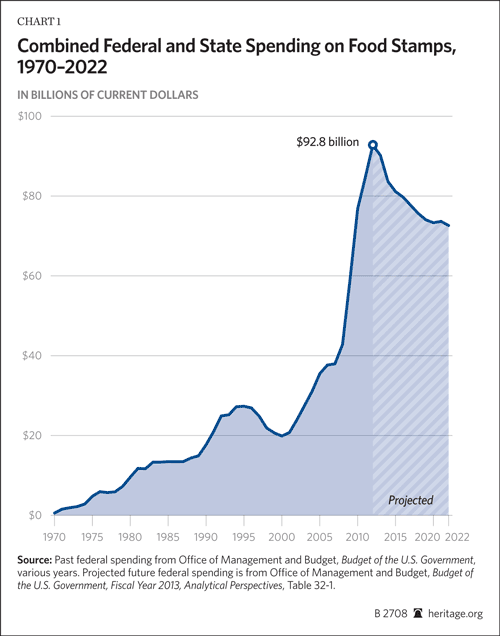A recent US News & World Report article set out to unveil the “facts” about food stamps.
What are the so-called “facts”?
For one, the article claims that the food stamps program is not “bloated,” but rather, the surge in participation and spending is a result of the program “doing what it’s supposed to do.”
But what is it “supposed to do”?
Food stamps (or the Supplemental Nutrition Assistance Program (SNAP), as it is now called) were designed to ensure that Americans without the ability to provide for themselves are able to receive basic nutrition. However, application loopholes and policy changes over the past decade or so have allowed recipients to bypass income and asset tests, meaning many people are receiving food stamps who would not have been eligible under the program’s original purposes.
One of the changes in eligibility requirements is “broad-based categorical eligibility.” This type of eligibility means that an individual who receives any service under another welfare program, such as Temporary Assistance for Needy Families (TANF)—even something as small as a TANF brochure—can be deemed eligible for food stamps. A full 50 percent of all food stamp recipients now enroll in the program through this broad-based categorical eligibility procedure. As Heritage welfare experts Robert Rector and Kiki Bradley write:
In states using this loophole, a middle-class family with one earner who becomes unemployed for one or two months can receive $668 per month in food stamps even if the family has $20,000 in cash sitting in the bank. Because of this, food stamps has been transformed from a program for the truly needy to a routine bonus payment stacked on top of conventional unemployment benefits.
In addition, the U.S. Department of Agriculture (USDA) has operated substantial outreach programs to pull more people onto the food stamp rolls. Some states have gone so far as to hire food stamp recruiters, tasked with filling a monthly quota of new food stamp enrollees.
Another “fact,” according to the author, is that much of the growth in food stamp costs is due to the recession and is temporary.
That’s partially true. Food stamp spending has roughly doubled in the past four years, and part of this is clearly due to the recession. However, food stamp spending has been on an upward climb since the program began back in the 1960s. In the decade prior to the recession, total government food stamp spending nearly doubled, from $19.8 billion in 2000 to $37.9 billion in 2007.
Moreover, according to Obama’s budget plans, food stamp spending will not return to pre-recession levels when the economy improves. “For most of the next decade, food stamp spending, adjusted for inflation and population growth, would remain at nearly twice the levels seen during the non-recessionary periods under President Bill Clinton,” note Rector and Bradley.
What’s more, food stamps are just one of roughly 80 federally funded means-tested welfare programs. The total cost of government welfare spending has been on a nearly continual climb over the past five decades and has increased 16-fold, to nearly $1 trillion annually, since the 1960s. Welfare is the fastest growing part of government spending, and under Obama’s fiscal year 2013 budget, total welfare spending will permanently increase from 4.5 percent of gross domestic product (GDP) to 6 percent of GDP.
US News & World Report also suggests as a “fact” that most food stamp recipients work.
However, a significant portion of able-bodied recipients of food stamps perform little to no work. Of the roughly 10.5 million households receiving food stamps containing an able-bodied, non-elderly adult (there are approximately 20 million households receiving food stamps total), more than half—5.5 million—performed no work during a given month in 2010. Another 1.5 million to 2 million performed fewer than 30 hours of work per week. This isn’t unique to the recession, but is typical even during good economic times.
The food stamp program is just one of dozens that comprise the complex system of federal means-tested welfare programs. Instead of continuing to pour more dollars into these programs, which have failed to promote self-sufficiency, policymakers should roll back aggregate spending on means-tested welfare to pre-recession levels when employment recovers. Likewise, programs like food stamps should be reformed to promote self-reliance through work, empowering individuals and families to become free from government dependence.






























